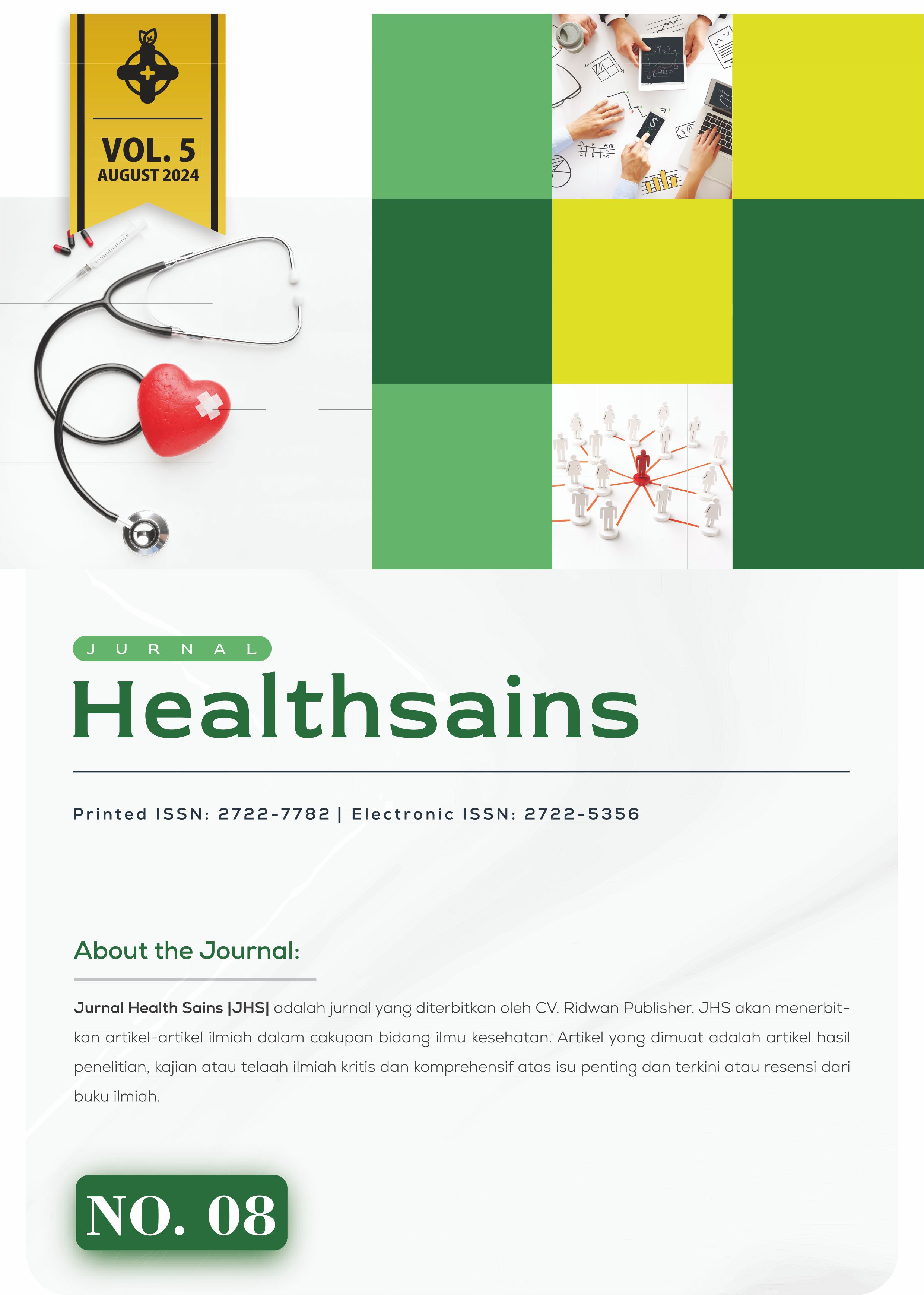Dyslipidemia And Hypertension Among Indonesian Hajj Pilgrims: A Cross-Sectional Study
DOI:
https://doi.org/10.46799/jhs.v5i8.1344Keywords:
Cardiovascular Disease, Dyslipidemia, Hypertension, Risk FactorAbstract
There has been an increase in the preval_ence of cardiovascular disease in Indonesia due to an increased preval_ence of hypertension. Cardiovascular disease is the primary cause of morbidity and mortality among Indonesian Hajj pilgrims. Dyslipidemia and hypertension are positively correlated, with dyslipidemia potentially contributing to hypertension through the mechanism of atherosclerosis. The primary objective of this study is to identify the association between hypertension and dyslipidemia among Indonesian hajj pilgrims. A cross-sectional study involving 114,069 participants in total. The Indonesian Hajj pilgrims in 2023 were the research population. Pre-embarkation medical exams were performed by qualified healthcare professionals, and data were taken from Hajj medical service records. Using bivariate analysis and the Chi-Square (χ2) test, the proportions of age and gender were compared between the hypertension and non-hypertension groups. The relationship between triglyceride, HDL, and LDL levels and hypertension was determined through logistic regression analysis. Logistic regression analysis was used to provide a multivariate analysis of the relationship between dyslipidemia and hypertension. The hypertension group has an average age of 60.2 + 11.6 years old (p<0.0001). There was no difference in the effect of gender on hypertension (p=0.105). HDL, LDL, and Triglyceride serum levels significantly affected the preval_ence of hypertension (p<0.0001). Dyslipidemia was a risk factor for hypertension with an OR of 1.084 (1.057-1.112) (95% CI). Dyslipidemia is a risk factor for hypertension. Serum levels of HDL, LDL, and triglycerides affect blood pressure.
References
Berberich, Amanda J., & Hegele, Robert A. (2022). A modern approach to dyslipidemia. Endocrine Reviews, 43(4), 611–653.
Chen, Ming Ming, Huang, Xuewei, Xu, Chengsheng, Song, Xiao Hui, Liu, Ye Mao, Yao, Dongai, Lu, Huiming, Wang, Gang, Zhang, Gui Lan, & Chen, Ze. (2022). High remnant cholesterol level potentiates the development of hypertension. Frontiers in Endocrinology, 13, 830347.
Chen, Siwei, & Cheng, Wenke. (2022). Relationship between lipid profiles and hypertension: a cross-sectional study of 62,957 Chinese adult males. Frontiers in Public Health, 10, 895499.
Chruściel, Piotr, Stemplewska, Paulina, Stemplewski, Adam, Wattad, Mohamad, Bielecka-Dąbrowa, Agata, Maciejewski, Marek, Penson, Peter, Bartlomiejczyk, Marcin A., & Banach, Maciej. (2022). Associations between the lipid profile and the development of hypertension in young individuals–the preliminary study. Archives of Medical Science: AMS, 18(1), 25.
Dąbrowska, Edyta, & Narkiewicz, Krzysztof. (2023). Hypertension and dyslipidemia: the two partners in endothelium-related crime. Current Atherosclerosis Reports, 25(9), 605–612.
do Vale, Gabriel T., Leoni, Drieli, Sousa, Arthur H., Gonzaga, Natália A., Uliana, Daniela L., La Gata, Davi C., Resstel, Leonardo B., Padovan, Cláudia M., & Tirapelli, Carlos R. (2020). Acute restraint stress increases blood pressure and oxidative stress in the cardiorenal system of rats: a role for AT1 receptors. Stress, 23(3), 328–337.
Haba, Cristian Mihai Stefan, Mitu, Ovidiu, Al Namat, Razan, Mitu, Ivona, Aursulesei, Viviana, Mitu, Florin, & Costache, Irina. (2019). Relationship between lipid profile and blood pressure in hypertensive patients. Journal of Hypertension Research, 5(1), 35–42.
Harrison, David G., Coffman, Thomas M., & Wilcox, Christopher S. (2021). Pathophysiology of hypertension: the mosaic theory and beyond. Circulation Research, 128(7), 847–863.
Indonesia, Perkumpulan Endokrinologi. (2021). Panduan Pengelolaan Dislipidemia di Indonesia 2021. Jakarta: PERKENI.
Ri, Kemenkes. (2018). Laporan Riskesdas 2018 Kementrian Kesehatan Republik Indonesia. Laporan Nasional Riskesdas, 53(9), 154–165.
Shaito, Abdullah, Aramouni, Karl, Assaf, Roland, Parenti, Astrid, Orekhov, Alexander, El Yazbi, Ahmed, Pintus, Gianfranco, & Eid, Ali H. (2022). Oxidative stress-induced endothelial dysfunction in cardiovascular diseases.
Widhidewi, N. W., Masyeni, S., & Pratiwi, A. Eka. (2020). Identification of cardiovascular risk factors among Hajj pilgrims from Bali in 2018. In Medical Technology and Environmental Health (pp. 320–324). CRC Press.
Williams, Bryan, Mancia, Giuseppe, Spiering, Wilko, Agabiti Rosei, Enrico, Azizi, Michel, Burnier, Michel, Clement, Denis L., Coca, Antonio, De Simone, Giovanni, & Dominiczak, Anna. (2018). 2018 ESC/ESH Guidelines for the management of arterial hypertension: The Task Force for the management of arterial hypertension of the European Society of Cardiology (ESC) and the European Society of Hypertension (ESH). European Heart Journal, 39(33), 3021–3104.
Wyszyńska, Justyna, Łuszczki, Edyta, Sobek, Grzegorz, Mazur, Artur, & Dereń, Katarzyna. (2023). Association and risk factors for hypertension and dyslipidemia in young adults from Poland. International Journal of Environmental Research and Public Health, 20(2), 982.
Zhou, Bin, Carrillo-Larco, Rodrigo M., Danaei, Goodarz, Riley, Leanne M., Paciorek, Christopher J., Stevens, Gretchen A., Gregg, Edward W., Bennett, James E., Solomon, Bethlehem, & Singleton, Rosie K. (2021). Worldwide trends in hypertension prevalence and progress in treatment and control from 1990 to 2019: a pooled analysis of 1201 population-representative studies with 104 million participants. The Lancet, 398(10304), 957–980.
Published
Issue
Section
License
Copyright (c) 2024 Meity Ardiana, Wira Nirwana

This work is licensed under a Creative Commons Attribution-ShareAlike 4.0 International License.
Authors who publish with this journal agree to the following terms:
- Authors retain copyright and grant the journal right of first publication with the work simultaneously licensed under aCreative Commons Attribution-ShareAlike 4.0 International (CC-BY-SA). that allows others to share the work with an acknowledgement of the work's authorship and initial publication in this journal.
- Authors are able to enter into separate, additional contractual arrangements for the non-exclusive distribution of the journal's published version of the work (e.g., post it to an institutional repository or publish it in a book), with an acknowledgement of its initial publication in this journal.
- Authors are permitted and encouraged to post their work online (e.g., in institutional repositories or on their website) prior to and during the submission process, as it can lead to productive exchanges, as well as earlier and greater citation of published work.









